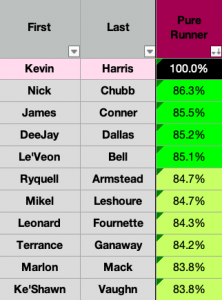South Carolina’s Kevin Harris is the next subject in a series in which I evaluate 2022 rookie running backs solely on their ability to run the ball. The Breakout Finder installments can be found here. The six PlayerProfiler installments can be found here. If you happened to already catch those and don’t need a refresher on my methodology, feel free to skip to the player-focused analysis.

I put off collecting data on South Carolina’s Kevin Harris for a while because an initial glance at his career stats didn’t impress me. And I also wasn’t seeing anybody excited about him on Twitter or at other scouting or dynasty outlets. He barely contributed as a true freshman, served as the lead runner for the Gamecocks as a sophomore, and then fell back down to earth in 2021: meh. However, my deeper dive revealed him to be a much more interesting player than I initially thought. Let’s explore his rushing efficiency profile.
The Metrics
Kevin Harris carried the ball a relatively modest 358 times in his career. And he posted a YPC+ mark of 0.46 on those attempts. That’s 31st-percentile volume and 48th-percentile (both among backs drafted since 2007) team-relative per-carry output. So at first glance, he’s nothing special. His career Chunk Rate+ is similarly mediocre at 0.02-percent, a 41st-percentile number.
Where Harris was a bit more impressive was in the open field. He turned 34.0-percent of his 10-yard runs into breakaways of 20+ yards, a Breakaway Conversion Rate in the 65th-percentile.
His team-relative stats also look a bit better in light of the talent-level of the teammates he’s being compared to, as well as of the relatively difficult path to efficiency that he faced. Harris’ backfield mates averaged a collective 3.56-star rating as high school recruits. This makes them a 62nd-percentile group. And relative to that group, the average box count that Harris ran against was incredibly high. He faced 0.40 more defenders in the box, on average, than his teammates did. It’s the greatest discrepancy in my database by some margin. Only Kenny Gainwell and Abram Smith can also boast Box Count+ numbers above the 0.30 mark. And theirs both come in at 0.33.
BAE Rating
Not only was Harris more efficient than his quality teammates. He was so while facing extremely heavy box counts and managing to be both consistent on a per carry basis and dynamic in the open field. Seems good.

Accounting for those heavy boxes means that the average Harris carry was worth 119.5-percent the output of the average non-Harris carry during his career as a Gamecock. This very nice Box-Adjusted Efficiency Rating lands in the 69th-percentile. Even more impressive is his Relative Success Rate. Success Rate assigns a binary success/failure tag to the outcome of each rushing attempt based on yards gained as well as down and distance prior to the snap. The use of “relative” here means adjusted for box counts in the same way that BAE Rating is; a 7.2-percent mark that is the third-highest in the class.
Rushing Efficiency Score and Comps
Based on all the non-box count metrics we’ve touched on (in addition to overall team quality, rushing volume, offensive line play, and strength of opponent), Harris earns a 43.5 out of 100 in my model’s composite Rushing Efficiency Score. In a composite built around BAE Rating and RSR, he earns a 73.0, the fourth-highest score in the class.
Using the same stats that contribute to the Rushing Efficiency composite (meaning box count-adjusted metrics are not yet part of the equation, alas), I’m able to generate similarity scores between the profiles of current prospects and those of guys from the past. The comparison we’re interested in also takes into account physical measurables. Assuming he runs a 4.50 40-yard dash at a projected 5-10 and 222-pounds, the following historical prospects had the most comparable “pure runner” profiles to his:

Even without considering the fact that he was running against some of the heaviest boxes we’ve seen, Harris’ combination of size, speed, and rushing efficiency means he comps closely to some of the best pure runners of the NFL’s last half-decade.
Last Word
I’m not saying that Kevin Harris is Nick Chubb or Le’Veon Bell. He does deserve far more attention as a potential late-round gem in this rookie class than he is currently getting. Which, as far as I can tell, is none.
Given the cheap investment you’ll have to make in order to acquire his services in dynasty, it’s simply irresponsible to leave a rookie draft without Harris on your roster.
